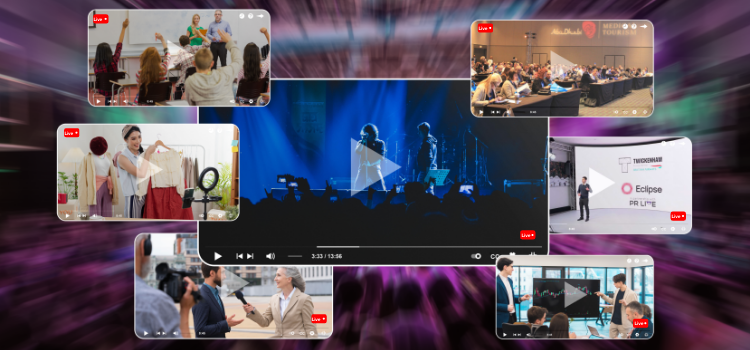Events are a great way to collaborate, celebrate, and discuss, but post-COVID-19, the world has greatly changed its way of consuming events.
Live streaming has come into the big picture, paving new pathways for all social events.
The benefits and reach of live streaming an events are mammoth when it comes to location-based participation.
But where does one get started, how to live stream an event, the best way to live stream an event, and how to reap the benefits of it? To answer all these questions, read through the article.
- Fully Customizable
- Lifetime Ownership
- On-Premise/On-Cloud
- 100% White-label
- Zero Revenue Share
- Hire Developers
Table of Contents
What Is Live Event Streaming?
When you say live streaming an event, you are broadcasting it over the internet in real-time to millions of viewers at a time. with right live streaming solution, you can seamlessly stream events like Live webinars, concerts, product launches, conferences, and board meetings that can help you to connect with more target audiences due to the accessibility and capabilities of the virtual space. These live streams can also be recorded to be viewed later as video-on-demand, thereby expanding the opportunities for a higher viewer rate.
Why Must You Know How To Livestream An Event?
Understanding the reasons on how to livestream an event will help you move ahead of competitors by letting you focus on the what lacks in your journey of live streaming, so here is a list of elements that needs to be covered
- Increases participation: To bring in a different set of new audiences to a new event involves huge money and it’s a difficult task for streamers, live streaming on the other hand uses social media to bring in more audiences.
- Learn about your audience: Knowledge about your audience is crucial, as it helps you determine your content and target space more effectively. Without audience awareness you might end up delivering wrong information to the wrong set of audiences.
- Share the moment: Get positive feedback from your viewers and share it on social platforms, capture the best moments in your session and make it a cherishable and audience driving aspect.
- Enhances Brand Awareness: Builds your brand identity across the globe by letting you be known by a new viewer base. Branding options like themes, logos, icon additions add more value to your brand while live streaming.
- Real-time engagement: Creating a space to interact with potential customers is a huge task, live streaming opens up an opportunity to it. Engagement is made possible with real-time chat and other interactive tools like polls, emoticons and feedback submission.
- Cost-effectiveness: Conducting an offline event with business customers sums to a huge amount of money, time and human management, whereas live streaming cuts down on those while bringing more space for new audiences.
Step-by-Step Guide: How to Livestream an Event Successfully

To live stream an event, you’ll need careful planning and the right tools. Start by choosing a platform like YouTube, Facebook OnTheFly, or Twitch.
1. Choosing The Right Platform
Selecting the right streaming platform is very important. Some of the best live streaming platforms include OnTheFly, YouTube, Facebook Live, Twitch, and Instagram.
2. Target Your Audience
Fix a goal and target audience on whichever platform you are choosing to use. Utilize the platform’s unique features.
3. Internet Essentials
Make space for quality audio and video equipment, ensuring a professional streaming output.
- A high-definition camera
- a dedicated microphone,
- a stable and high-speed internet connection
- proper lighting are a must
Test-run your equipment beforehand to avoid technical glitches.
4. Selecting An Encoder
An encoder is a tool used to convert your audio and video signals into a format suitable for online streaming. There are two types of encoder hardware and software, and the best available software options include OBS Studio, Streamlabs OBS, and XSplit.
5. Streaming Setup
Set up a proper video resolution, frame rate, bitrate, and encoder settings for better streaming quality.
6. Rehearse Beforehand
Conduct rehearsals for your streaming event to avoid issues while streaming so that it helps in delivering a professional live stream.
7. Engaging Your Audience
Interacting with your audience is crucial, so choose a platform with real-time chat features to answer questions and acknowledge feedback. Engage them with polls, contests, or Q&A sessions during the event.
8. Promotion And Marketing
Utilize social media, email, influencers, and your website to create promotion for your event. Share snippets, reels, and BTS content to build anticipation.
Collaborate with influencers to maximize your reach and attract a wider audience.
9. Monetization Strategies
Explore monetization! There are plenty of platforms where monetization is available for live streaming without compromising on the viewer experience.
10. Monitoring And Analytics
Monitor viewer count and engagement levels and understand the data to improve your streaming in real-time. Analyze the insights into audience demographics for future optimizations.
11. Recording And Repurposing Content
Save your live stream for future use. Repurpose the content into shorter clips, blog posts or create live podcasts, to maximize its value and reach a broader audience over time.
Which Events Can You Live Stream?

Here are some use cases where content creators can make use of live streaming in different industries:
Product Launches: Live streaming can be highly effective if industries release products to people from different parts of the world with a live, engaging event.
Conferences: Live streaming conferences build a sense of collaborative discussions, interviews, and panel discussions and save a lot of effort and time.
Concerts And Festivals: Live streaming a concert or music festival is feasible and generates more income with fans and followers to participate from different parts of the world. Post-COVID, most of the film festivals are conducted online, with a huge number of participants.
Educational Workshops And Classes: Live streaming educational classes help students engage consciously with digital learning by asking questions in real time.
Live Shopping Event: Live streaming increases the sales of e-commerce businesses by hosting a shoppable live stream featuring product demos. This increases your brand value and creates a new shopping experience for viewers.
Earnings call: Businesses use live streaming earnings calls for a wide range of purposes, from investor relations and transparency to personal branding and Q&A sessions.
Companies like Tesla and Alphabet are currently putting this into action.
Trade Shows: Online Trade shows and exhibitions let vendors go virtual and host online booths so that online viewers can interact and get with their products and services easily.
Recommended Reading
What Are The Benefits Of Live Streaming An Event?
If you are looking for answers to live stream your event in perfection, you need to know the various benefits you would enjoy even as a first-time live streamer.
Wider Audience Reach
By streaming events, you get the chance to build a community. Live streaming platforms come with the benefit of letting you have a real-time chat with your audience, thereby you can know their comments and feedback and can do your work better in the next event. This helps you reach wider audiences and stay connected with them for any forthcoming events that you wish to stream.
Cost-Effective
Unlike in-person events, live streaming an event requires less effort and drastically lower cost. All you need to spend on is a good live-streaming platform that supports multistreaming to various destinations simultaneously, without compromising on a stable internet connection. Isn’t this the most important benefit you ever need?
Real-Time Engagement
You get a very good chance to build engagement with your live audience. While looking for ways to stay connected, consider including your viewers’ voices in decision-making by generating polls, surveys, and Q&A sessions to understand their behaviors and gain insights into their preferences and feedback. You can maximize the number of audience members by converting your viewers into long-term followers, offering them a space to join a community or access your other Livestream shows or recorded videos continuously.
Exploring New Income Stream
At the end of the day, everything is about earning and converting your talents and progress into income. So when you live stream, you are paving the way for a tenfold return on investment 10x ROI. Try collaborating with other famous live streamers to gain double credits. You can also multiply your income by using marketing strategies, analyzing your streaming performance, and promoting your show to a larger audience through more marketing efforts. Also, the main thing to look for in a live streaming platform is the option to record your live event or pre-record your event for scheduling it later at your convenience.
Building Brand Awareness
You can showcase your brand at its best by adding your logo, music, images, videos, ads, overlays, captions, and much more to your stream, displaying your brand throughout the show. Also, try merchandising and getting sponsorships to build brand awareness while simultaneously expanding your earning possibilities.
Preparation For Live Streaming
Before going for a live streaming event, make sure you ask these questions:
- What is the purpose of live streaming that event?
- Which platform is best for live streaming?
- What are the features of streaming?
- Will you monetize the event?
Stream Easily on all Social Media Platforms Hassle Free
- Keep it simple- Don’t complicate your live stream, schedule the event with a time table and act accordingly, sometimes exposing your timetable to your audience will help them prepare their activities.
- Practice the event, if possible- Rehearse before act, as it may not lead you to make mistakes during the live stream, hundreds of possibilities are there for a technical glitch, so keep backup for all your equipment.
- Reduce the CPU’s workload- Test run your PC because the CPU might crash with the overload of the performance of the software you are using for live stream.
- Engage the audience- Use interactive tools like real-time chat, polls, and collect constant feedback to engage your audience throughout the live streaming session, a monotonous singular conversation will bore the audience.
Takeaway
In conclusion, by following these steps, you can create a compelling and memorable live stream experience for your audience. Successful live streaming requires a thoughtful approach encompassing platform selection, technical setup, audience engagement, promotion, and post-event strategies.
- Request Demo Book a Live, Personalized Demo
- Contact Sales Reach Out to Our OTT Experts
Frequently Asked Questions
Why Is live-streaming events important?
Live streaming events drive more engagement, create new opportunities for business development, increase your business identity to millions of viewers and bring in better results.
What platform is best for live streaming?
OnTheFly is the best platform for live streaming videos and pre-recorded videos, it offers multiple features like studio-grade recording, Multi streaming, Studio branding, Individual Live analytics, Live Webinar, Face Visual effects.
What is the purpose of livestream?
Live stream broadcasting serves many purposes, it brings in more engagement, increases viewership, builds brand awareness and creates business opportunities.
How does OnTheFly support online live streaming events?
OnTheFly offers multistreaming possibilities thereby opening a space for more viewership and business in multiple social media platforms like youtube, facebook, twitch and 50+ other platforms.
How do I host my own event?
Once you register your profile in OnTheFly by filling in the basic details, you can start hosting your event right away in minutes.


Looking for live streaming platforms with multi stream option. I’d love to hear more about successful implementations or any tips you might have?